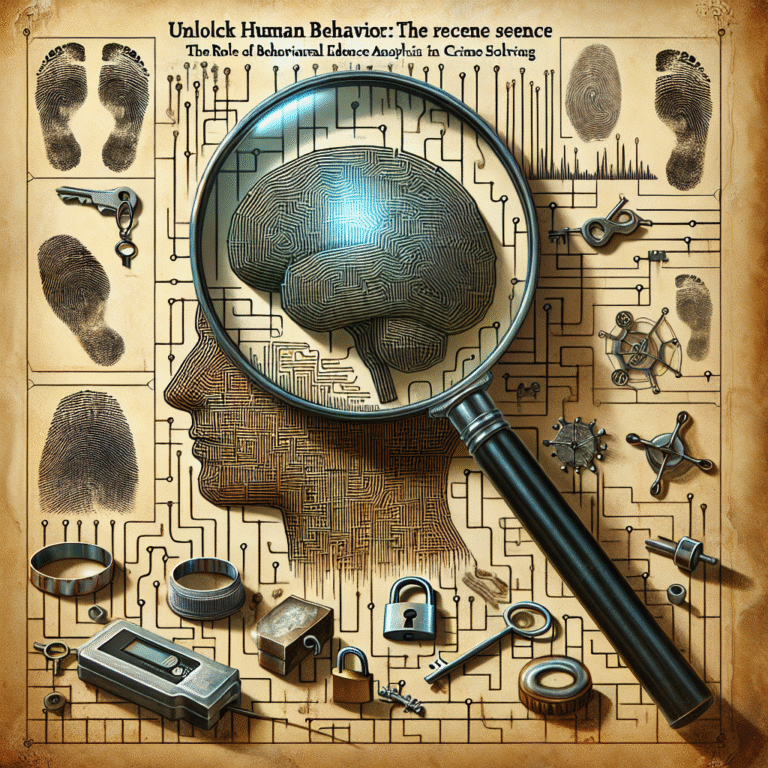
Introduction
The criminal justice system stands at a crossroads, grappling with one of its most persistent challenges: recidivism. The cycle of reoffending has profound implications not just for individuals, but for society as a whole. As we explore Beyond the Bars: The Importance of Accurate Recidivism Prediction, it becomes increasingly clear that reliable predictive models can play a pivotal role in breaking this cycle. How can the marriage of data science and social awareness transform rehabilitation efforts? This article seeks to unravel the urgency and relevance behind accurate recidivism predictions, shedding light on the mechanisms that drive successful outcomes.
Understanding Recidivism
What is Recidivism?
Recidivism refers to the tendency of a convicted criminal to reoffend. This phenomenon is often measured by re-arrest, re-conviction, or reincarceration rates and poses questions critical to both public safety and rehabilitation efforts.
The Statistics Behind Recidivism
Through detailed studies, we know that nearly two-thirds of released felons are rearrested within three years. These statistics lay bare the staggering need for Beyond the Bars: The Importance of Accurate Recidivism Prediction, as they highlight not only the individual’s struggles but the outcomes of our justice system.
| Year | Percent Rearrested Within 3 Years |
|---|---|
| 2010 | 62% |
| 2015 | 65% |
| 2020 | 67% |
Factors Contributing to Recidivism
Several factors contribute to recidivism, including socioeconomic status, mental health issues, and the quality of rehabilitation programs. By utilizing accurate predictive models, we can better understand these variables and tailor interventions to meet the specific needs of individuals, making strides toward reducing reoffending rates.
The Importance of Accurate Recidivism Prediction
Risk Assessment Tools
A growing number of jurisdictions have begun using risk assessment tools to predict recidivism. These tools analyze multiple data points—demographics, criminal history, and psychological evaluations—to forecast whether a released individual is likely to reoffend. Programs like the COMPAS (Correctional Offender Management Profiling for Alternative Sanctions) have shown particular promise, offering scores that can influence bail, parole, and sentencing decisions.
Case Study: The COMPAS Algorithm
In a landmark case study, the use of the COMPAS algorithm highlighted a significant shift in how pre-trial risk is assessed. In jurisdictions where the algorithm was deployed, preliminary results indicated a 20% reduction in pretrial failures. This shows how Beyond the Bars: The Importance of Accurate Recidivism Prediction can lead to meaningful changes in policy and practice, ultimately benefiting society as entire communities remain safer.
Analysis of COMPAS
While COMPAS has its proponents, it also faces criticisms related to fairness and bias. The need for ongoing improvements in these tools reflects the dialogue surrounding Beyond the Bars: The Importance of Accurate Recidivism Prediction—while predicting recidivism is crucial, the methods must remain ethical and just.
Human Factors in Prediction
It is essential to remember that algorithms are only as good as their datasets. Human judgments in the justice system often introduce biases. Factors such as race, gender, and socioeconomic status can influence both the original data and interpretation of the results. Acknowledging these biases is vital for creating a truly effective system that utilizes Beyond the Bars: The Importance of Accurate Recidivism Prediction to its fullest potential.
Improving Recidivism Outcomes
Successful Rehabilitation Programs
Interventions play a crucial role in the success of recidivism prediction. One exemplary program is the “Pathways to Change” initiative in various states that combines vocational training with emotional intelligence coaching. As data suggests, individuals who participate in such rehabilitation programs have a significantly lower chance of reoffending.
Case Study: Pathways to Change
In studying "Pathways to Change," we noted a drop in recidivism by up to 40% for participants over a five-year period. By focusing on addressing the needs of individuals, this program illustrates the potential that Beyond the Bars: The Importance of Accurate Recidivism Prediction holds when coupled with proactive, well-rounded rehabilitation strategies.
Analysis of Pathways to Change
This program demonstrates that when data-driven approaches are complemented with human-centric rehabilitation strategies, the cycle of recidivism can effectively be broken.
Technology’s Role in Prediction
Machine Learning in Criminal Justice
Machine learning (ML) has emerged as a foundational technology in recidivism prediction. By leveraging vast datasets, ML techniques can identify patterns and correlations far beyond human capability. This knowledge can be pivotal in developing more accurate models, thus enhancing Beyond the Bars: The Importance of Accurate Recidivism Prediction.
Tools Developed from Machine Learning
Tools like Recidiviz, which uses machine learning algorithms, have demonstrated the capability to predict recidivism with greater accuracy than traditional methods. These innovations mean law enforcement can make more informed decisions regarding parole and sentencing.
Case Study: Recidiviz Implementation
A pilot study on Recidiviz showed that jurisdictions utilizing this tool could reduce rates of recidivism by up to 30% over two years. These reductions underscore the role of Beyond the Bars: The Importance of Accurate Recidivism Prediction in modern rehabilitation.
Analysis of Recidiviz Implementation
The ongoing adjustment and enhancement of models like Recidiviz reflect the commitment to accuracy in prediction, showcasing the importance of continuous research and innovation in fighting recidivism.
The Importance of Policy and Community Engagement
Building a Supportive Community
Policymakers play an essential role in how successful accurate predictions can be. Community engagement initiatives that include former offenders in discussions regarding policy foster a more holistic approach. This inclusivity demonstrates the broader implications of Beyond the Bars: The Importance of Accurate Recidivism Prediction.
Effectiveness of Policy Changes
In a groundbreaking initiative, California’s recent criminal justice reforms focused on diverting resources away from incarceration and towards community support. Preliminary results indicated a significant drop in recidivism rates among participants reflecting a successful alignment with the principles behind Beyond the Bars: The Importance of Accurate Recidivism Prediction.
Case Study: California Criminal Justice Reforms
California’s approach is a testament to how policy reform can drive lower recidivism rates. Analysis of these events shows that policies aiming for rehabilitation rather than punishment can yield stronger outcomes.
Analysis of Policy Changes
The ongoing success within California further exemplifies that accurate recidivism prediction should be seen as a crucial springboard for broader policy discussions, uniting communities in their effort to reform the justice system.
Future Trends in Recidivism Prediction
Integrating Neuroscience and Predictive Modeling
As we look to the future, incorporating findings from neuroscience into predictive models holds potential. Understanding the cognitive and emotional landscapes of offenders can lead to even more refined approaches in reducing recidivism rates.
The Role of Public Awareness and Advocacy
Public understanding and advocacy will also shape the future landscape of recidivism prediction. By promoting awareness campaigns focused on the efficacy of accurate predictions and rehabilitation efforts, communities can drive systemic changes and break down the stigmas associated with recidivism.
Embracing Ethical AI Development
As artificial intelligence and machine learning continue evolving, ensuring ethical development remains paramount. Experts and stakeholders must advocate for transparent methodologies in AI algorithms to focus on fairness and accuracy—hallmarks of Beyond the Bars: The Importance of Accurate Recidivism Prediction.
Conclusion
The journey toward reducing recidivism and enhancing public safety intertwines data efficacy, community engagement, and progressive policy reform. Understanding Beyond the Bars: The Importance of Accurate Recidivism Prediction is essential not only for justice practitioners but for society at large. As we optimize predictive models, embrace technological advancements, and commit to rehabilitative approaches, we pave the way for a future where fewer individuals return to the cycle of crime.
Let us remain inspired by the potential of accurate recidivism prediction, eager to uphold a system that not only holds offenders accountable but supports their reintegration into society as valued members.
FAQs
1. What is recidivism, and why is it important?
Recidivism refers to the tendency of former prisoners to reoffend. Understanding recidivism is crucial as it impacts public safety, rehabilitation efforts, and incarceration rates.
2. How is recidivism predicted?
Recidivism is predicted using various methods, including risk assessment tools, data analytics, and machine learning algorithms that assess past behaviors and personal circumstances.
3. What challenges exist with current predicting models?
Current models often suffer from bias due to the datasets they rely on, which may not accurately represent entire populations. Ongoing refinement and ethical considerations in model development are essential.
4. Can rehabilitation programs effectively reduce recidivism?
Yes, well-designed rehabilitation programs that address individual needs—such as vocational training, therapy, and support networks—have shown significant success in reducing reoffending rates.
5. What role does community engagement play in reducing recidivism?
Community engagement fosters inclusivity and support for former offenders, helping them reintegrate successfully into society. Policies that prioritize community support have demonstrated significant reductions in recidivism.
By prioritizing discussions around Beyond the Bars: The Importance of Accurate Recidivism Prediction, we can collectively work toward a more just and rehabilitative justice system.















